13 Jun The Power of Nurturing & Secure Love
My sister-in-law has now adopted 3 girls, all sisters. Below is the story of the first two girls and their road from foster care to adoption. Nurturing and secure love have played the biggest role in their lives, and I want to tell you how that has happened by letting my sister-in-law, Carie, share their story.
“I received a call in the grocery store at 3pm on February 18, 2014, only 2 months after completing the necessary paper work to become a foster parent. “Carie, I have a situation, can you talk?” It was the director of our agency and I knew this would be the call. Everything in the store seemed foggy and I completely forgot what I was there to get. All I heard her tell me was that she had two little girls (biological sisters that were 2 and 3) who had been in her office since 11am and needed a place to stay that night. Not going to lie, my first thought was “I’m sorry TWO girls and how old did you say?” My youngest son was 3 at that time and the oldest only 5, so this would be interesting. I called my husband and he did not even hesitate to say yes.
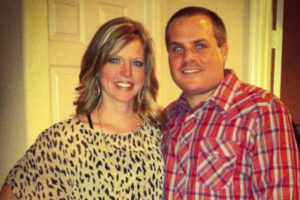
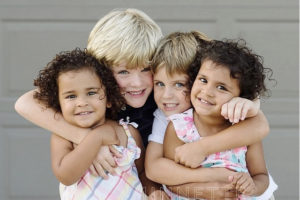
We met at the adoption agency’s office nervous and unsure of what that night would look like. My husband arrived before me and had bought the girls snacks to help break the ice. I walked in to see two brown curly headed little girls just staring at me with big brown eyes. Our eyes locked and to be honest I did not have that moment of “these are our daughters” like I always thought I would. Maybe that’s because I had my heart set on a baby or maybe not, but I remember feeling guilty, excited, nervous and overwhelmed all at the same time. That thought didn’t matter in that moment because these girls needed a safe and secure place where they could be loved unconditionally and I was absolutely going to make sure that happened. I noticed the oldest girl was so skinny and almost fragile looking and seemed incredibly anxious and shy…rightfully so. The youngest girl was bubbly and ran right up to us wanting to be held. These were things I just noticed and maybe that was my “mommy instinct” of wanting to asses the situation, swoop in to nurture and take care of the issues. Whatever the issues were, I was committed from that night on, for however long we had them, to do 2 things; Love them and make sure they were safe and secure.
After our first two weeks with them we found out they were available for adoption and we knew the cycle had to stop here. We would spend the next 14 months fighting, and I mean FIGHTING, for these little girls and their well being. It was not easy. In fact it was incredibly hard and a messy situation. It was extremely emotional and if I’m honest there were days I just wasn’t sure how it would all end, or if we had made a mistake. But, these girls had been placed with our agency 14 months prior, at the request of their 18yr old mother, because she was unable to care for them. They had been on and off the streets, in and out of shelters and had lived in 3 different homes prior to ours. The cycle had to stop and it had to stop NOW!’
The girls were delayed in speech and motor-skill development when they first came to our home. The younger sister had bald patches on her head of curls and her hair was incredibly dry. We had to guess at what she needed most of the time as her speech was difficult to understand. The 3yr old had stringy, brittle hair that almost looked grey. She was incredibly skinny and frail. Her face and eyes were continuously glassed over. All of this was as new to us as our home and family were to them, so we had had to educate ourselves and dive into their story if were going to be able to provide any kind of real help for them. We didn’t know much at the time, but we did believe they could and WOULD heal and that our family would play a big part in how that was going to happen. I immediately set out to learn what they had been through, uncover any family history I could possibly find, ask questions and hopefully better understand how the trauma they had experienced had affected them both from a physiological perspective with brain development, as well as an emotional perspective.
The first two nights home bedtime was a REAL struggle for the the oldest girl. She remained silent and her eyes darted around the room constantly evaluating potential threats. In an attempt to calm herself she would chew on just about anything she could get her hands on, including her bed rail. It looked like a beaver had gone to town on that thing and yet there were no wood shavings to be found. Had she swallowed them? Did they just disappear? This is was so crazy but I knew it was due to her fear and anxiety. When we threatened to remove the bed rail if the chewing continued she began to chew the tips of her fingers until they bled. It was heart-breaking and confusing and we were just trying to figure it all out.
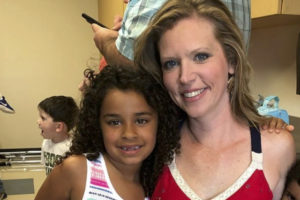
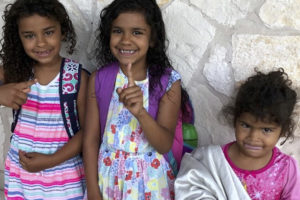
I knew in my gut that these girls needed consistency, security, patience, provision, and above all unconditional love. I had read and studied on the effects of trauma on children and in one article had learned about the need for some children to be re-trained in the bonding process that most children experience in the first year of life with their parents, and particularly the mother. Our oldest girl was lacking that big time, and the confusion regarding her situation and new surroundings was causing anxiety she just didn’t know how to process on her own. So, the next morning I asked my friend, who happens to be an occupational therapist, to send me some chewy toys, pacifiers and bottles.
Some people asked, “Why would you regress with her? Why the paci and bottle, she’s not a baby?”
Here’s why. I learned that children will revert back to the age where the intense trauma was first experienced. She was acting like a baby because she was not yet 2 years old at the time of her original placement. She needed to re-learn and re-experience that time and get the opportunity to bond and grow that she had been robbed of more than a year prior. It was at that point that I began to parent my 3 year old girl in a way I had never anticipated would be necessary. I pulled out my old baby wrap and began wearing her strapped to my chest 2-3 times a day for at least 30 min a time. When my husband would come home from work he would do the same. Initially, he thought we had lost our minds but after hearing my my explanation as to what I thought was going on he agreed to do whatever it took. And I can tell you, he never looked so good as when he had our daughter strapped to his chest. That’s a real man.
To our surprise, and much welcomed amazement, any time we would put this sweet girl in our baby wrap she would tuck her knees to her chest and at times even put her hands down my
shirt just like my two boys would do when they were infants. She would babble like a newborn baby and chew on her paci like it was a piece of bubble gum. She would drink water from a bottle, and yes, it seemed for a 3 year old to behave like this, but it was how she needed to be loved and I knew it wouldn’t last forever.
The younger daughter couldn’t speak much either. When she did speak it was mostly babble and typically involved her wanting to be held in some capacity. However, she always had a good demeanor, was super sweet, and called us mommy and daddy early on. This may sound like a good thing, like she was handling the transition much better than her sister, but in reality she was simply on the opposite side of the attachment disorder spectrum than her sister. Her willingness to attach so quickly, though looked and felt good on the surface, was actually a sign of something quite sad and heart-breaking. It was a sign that her heart had grown so calloused to all the transitions and neglect that she was willing to see any care taker (male and female) as mom and dad. Those titles were not reserved for two specific people whom she knew loved and cared for her in a unique way, they simply meant the latest person to hold her, feed her, changer her diaper. She had learned to attach and detach without being fazed, or so you think. Kids with this type of detachment disorder seem acclimated and healthy throughout their childhood, but in the teenage years, when the lack of attachment rears its ugly head, the real issues begin to surface. Our younger daughter also needed to be re-trained and bonded with before her detachment grew any deeper.
This sweet and sassy girl seemed to be more nourished and cared for, BUT we soon noticed that she was hoarding food, which is a typical sign of major neglect. We would find her at times in the pantry with the door closed eating and her eyes as big as saucers when she got caught.
She would sneak food in her room. We would find food under blankets, under her bed, in the closet, and even in the toy box. What was up with this? Was she worried about when she might eat again? Was she worried she wouldn’t get enough food? “What in the world is she doing?” we thought to ourselves. We moved up snack times and ate more frequently toreassure her.
After the bonding needs, nutritional needs quickly became our second focus. Our 3 year old was in the 10th percentile for her age and the 2 year old was in the 40th. Both seemed frail and weak in their own ways and we knew getting the right kinds of foods in them would make a world of difference. At first they wouldn’t eat much but, after that first week fruit became a staple. It was as if their bodies were craving it.
Over the course of the next few weeks and months we would make it our priority to not only nurture them with love and safety but also with food and diet. We were on a mission to immediately see these girls heal physically, emotionally and spiritually. From holding and snuggling to playing, laughing, dancing and eating, we made sure they knew they were safe and loved. Our boys struggled a bit with the divided attention at first, but adjusted as well as possible in the first few months and grew right along with us as parents. It was a difficult and daily struggle, but it was so worth it.
On April 10, 2015 after 14 months of being foster parents we walked into a courthouse and FINALLY made these precious girls our DAUGHTERS! For the first time they had a secure and loving forever family and they were thriving. Our oldest had grown from the 10th percentile to the 60th. Her hair was healthy, shiny and curly. She still struggled with anxiety but was smiling more and more. For the first time since we had met her she had a light in her eyes, was talking in complete sentences for the most part and was extremely active. This was HUGE!
Our youngest Daughter grew from the 40th to the 90th percentile. She had a full head of gorgeous ringlets, a great vocabulary and was walking and running much better. We were beaming with joy and so were our boys. They were so excited to have sisters and to make them a part of our family forever.”
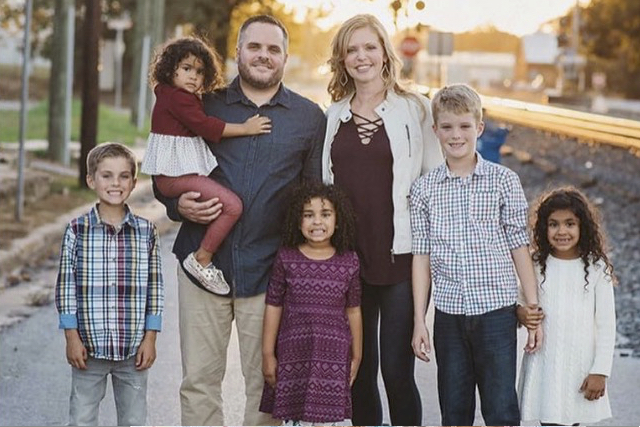
There are children all around the world, including at Casa Vallado, who have experiences, or currently are experiencing, that kind of trauma and are very much in need of that kind of love. It is our aim at The Vallado Project to do what we can to partner with organizations in Mexico, as well as other nations, to help provide the nourishment, love and support these children need to grow and thrive.
You can be part of that solution by clicking one of the links below. We have what they need!
– Elisabeth Brown; The Vallado Project



